 |

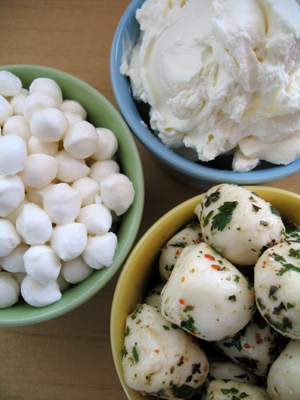 |
| We honor the aged, but these youths have it going on. Above, Mozzarella Fresca’s thick mascarpone, wee perlini and bite-size ciliegine marinated in olive oil, herbs and spices. Photo by Melody Lan. |
| WHAT IT IS: The finest-quality mascarpone, ricotta, and other classic, fresh Italian cow’s milk cheeses. |
| WHY IT’S DIFFERENT: Incredibly pure, clean, rich flavors. One bite and you know you’re tasting the best. |
| WHY WE LOVE IT: Made by a third-generation Italian cheesemaker in the California dairy heartland, everything—technique, ingredients, passion, commitment and equipment—combines to make the products memorable. |
|
|
 |

Mozzarella Fresca:
Wholly Cheeses
CAPSULE REPORT: Most people go gaga over the great, aged cheeses of the U.S. and Europe. We include ourselves in that group. But we’re so religiously devoted to the equally splendid fresh cheeses that we usually breeze past the Stiltons and Parmigiano-Reggianos to sample the fare from Mozzarella Fresca. Their mascarpone, mozzarellas and ricotta are the best we’ve ever tasted on these shores. Lovers of fine food should find an occasion to enjoy them sooner rather than later.
You don’t need to cook a thing: we eat these delicious cheeses right out of the container (or on more civilized plating) and feel a healthy, spiritual refreshment. Cooks will be excited to find better ingredients to make their favorite Italian dishes sparkle even more brightly. There are scores, maybe hundreds, of recipes on the company’s website. The cheeses are certified kosher. Read the full review below.
|
THE NIBBLE does not sell the food products we review or receive fees from manufacturers for recommending them. Our recommendations are based purely on our opinion, after tasting thousands of products each year, that they represent the best in their categories. |
Must-Have Books for The Cheese-Lovers Library (We Own Them All)
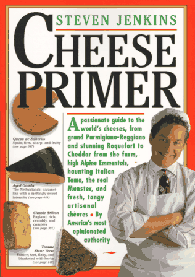 |
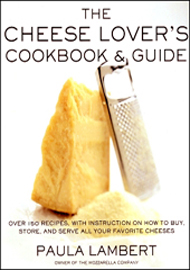 |
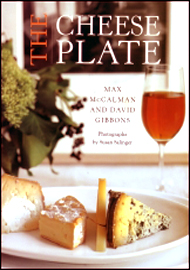 |
| Cheese Primer, by Steven Jenkins. The original book that taught Americans about cheese: more of an encyclopedia than a primer. It covers the U.S. and Europe, with maps and photos, historical and other relevant information. Updated and still the best primer. Click here for more information. |
Cheese Lover’s Cookbook & Guide, by Paula Lambert. A great book from America’s first lady of cheese. Ms. Lambert started her own company because, upon returning from a trip to Italy, she couldn’t find great cheese in Texas. The book includes lessons to make your own. Beautifully photographed. Click here for more information. |
The Cheese Plate, by Max McCalman. Dean of Curriculum and Maître Fromager at Artisanal Premium Cheese Center and school in New York City, McCalman has produced a wonderful book. It includes perhaps the best published information about pairing cheese and wine. Click here for more information. |
Wholly Cheeses: Mozzarella Fresca’s Fresh Italian Cheeses
We eat the great cheeses of the world—kickin’ Cabrales and chèvres, regal Roqueforts and reblochons, fabulous fontinas d’Aosta and formaggios al tartuffo.* We personally know the King and Queen of Cheeses: Parmigiano-Reggiano and Brie. (Some say the king is Stilton, some claim it’s Roquefort, and in 1815, the Prince de Tallyrand named Brie “Le Roi de Fromages.” The heated battle could end in one heck of a fondue.) Yet, at the same industry food shows, where we could eat all we want of these pricey curds, we gravitate toward the imminently more affordable wares of what to us is an equally spiritual cheese experience: the best fresh, unaged cheeses.
*Why some cheeses are capitalized and others not: when a cheese is named after a geographical place that is capitalized, e.g. the valley of Aosta and the towns of Cabrales and Roquefort, we capitalize the cheese. Parmigiano means “of or from Parma,” and Reggiano means “of or from Reggio.” Parma and Reggio Emilia are two cities in north central Italy, the area of the cheese’s origin. If the cheese name comprises nouns or adjectives that are normally not capitalized, e.g. fromage blanc (white cheese), formaggio al tartuffo (truffle cheese) chèvre (goat) or cream cheese, we don’t capitalize it.
Some cheese purists might argue that these aren’t “real” cheeses because they aren’t cultured or don’t contain rennet; ricotta is acknowledged to be a cheese by-product, made from the whey of mozzarella. Discard those nits of reasoning: these are wholly cheeses, serious for anyone’s consideration. Yet, precisely for the reasons given, aside from a related fresh cheese like chèvre, the cheeses we’ll explore today almost never appear as part of a cheese plate offering. Instead, they take their place in dishes that can inspire awe before and after the cheese course. Frankly, a great ricotta, mascarpone or mozzarella—like those turned out by Mozzarella Fresca of Tipton, California—have earned our devotion just as much as the ripest, most mushroomy triple-crème brie. And there are those who would abandon the brie for a great Caprese salad: slices of fresh mozzarella and tomato with fresh basil.
Per capita consumption of cheese in America has tripled over the last 30 years, to 31 pounds per year. Some of this growth is due to our increasing sophistication about fine cheeses; but most is our consumption of common mozzarella on pizzas, and common cheddar, Swiss and American cheeses on burgers and omelets. If your principal acquaintance with mozzarella is of this quality, you are in for a treat.
You don’t have to be an avid cook, turning out homemade lasagna, stuffed shells and veal parmigiana, to embrace the product line. These cheeses are perfect culinary companions for those who don’t have the time or inclination to cook, but want to eat as joyously as those who have all day to spend with the masterworks of Mario, Giada and Lydia.
|

Most of our mozzarella consumption is the rubbery
variety on commercial pizza. Instead, buy a
crust at the supermarket, like this one from Boboli,
and make a pizza with Mozzarella Fresca’s fabulous mozzarella. There are many pizza recipes on the
Boboli website. This pizza uses the whole wheat thin
crust. Try it with smoked mozzarella. Making pizza
at home may become a favorite pastime! |
Why are these cheeses different from other brands? They taste “old country.” To everyone who says, “The cheese is so much better in Italy,” start here. The products are very much like imported varieties, made in the style of their Italian counterparts. They seem as authentic as if you were eating them at a farm in Tuscany. In fact, they will transport you there.
Perhaps it’s because a third-generation cheesemaker from the old country was enticed to California to make the cheeses. Perhaps it’s because Tipton, near Bakersfield, is located in California cow country. The dairy next door delivers fresh raw milk each morning that is pasteurized by Mozzarella Fresca, made into cheese and shipped out to retailers the same day (from the cow to your store in less than 24 hours, just like in the old country). Perhaps it’s the investment in a state-of-the-art plant, and the owner’s commitment to the best, constantly testing samples to ensure the highest standards. They’re made with the latest equipment, but the products are still made by hand. This ensures the perfect balance of moisture and texture and creates the beautiful consistency. It’s back-breaking work in very hot rooms but the craftsmanship pays off. In recognition, most of the products have won Best-of-Class and/or gold medals at the American Cheese Society Awards, U.S. Cheese Championship or World Cheese Championships.
Awards or not, we’re grateful. In a world of complex food, fancy food and expensive food, the delight in eating these simple yet great products can’t be beat. At less than $4.00 per package, no one need be deprived. Mozzarella, ricotta and mascarpone are easy cheeses to make—you can make them at home in two hours. To paraphrase Shakespeare, the quality’s the thing. Here, Mozzarella Fresca stands at the top of the podium.
Types Of Cheese
In the cheese world, there are three different types of fresh cheeses: cooked-curd, uncooked-curd and stretched-curd, or pasta filata. Mozzarella Fresca makes all three types; all are whole milk cheeses from cow’s milk:
- Mascarpone, an uncooked-curd cheese, plain and a special caramel variety called Dolce “dessert creme.”
- Mozzarella, a stretched-curd cheese, from balls for slicing and cooking to smaller perlini, bocconcini, ciliegine and ovoline; plus marinated mozzarella. (Mozzarella is made with rennet, by the way; Mozzarella Fresca uses vegetarian rennet.)
- Ricotta, a cooked-curd cheese that is found in many Italian recipes.
One thing to note about fresh cheeses is the word “fresh.” These are delicate, all-natural, preservative-free products. Depending on the cheese, they are meant to be consumed within five to seven days after the package is opened. Marinated mozzarella should be finished within 14 days. |
|
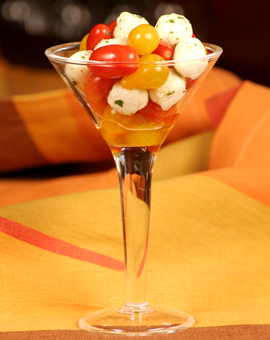
Use your martini glasses to make a “Mozzatini”:
marinated balls of fresh mozzarella (this size is
called ciliegine, pronounced chee-lee-eh-GEE-nee) and grape tomatoes. Ciliegine can be
purchased
marinated, or you can buy plain balls and make
your own vinaigrette.
|
Fresh Mozzarella
Mozzarella is part of the pasta filata family of Italian cheeses, which can range from very fresh to hard grating cheeses. Other family members include burrata, caciocavallo, Oaxaca, provolone, scamorza and string cheese. Pasta is simply the Italian word for paste or dough; filata means spun. In this case, the cheese is cooked and then spun or pulled from curd, unlike most cheeses where curds are drained and pressed into a mold. The word mozzarella itself comes from mozzare, to tear, and refers to the tearing of the stretched mozzarella to form balls (although the reverse is true: you can tear strips off of the perfectly smooth balls should you wish to eat the mozzarella in a “peeling the onion” fashion—as much fun as string cheese and so much tastier with Mozzarella Fresca).
The vast majority of fresh mozzarella is made from cow’s milk. Water buffalo’s milk (mozzarella di bufala), which has a higher fat content and produces a richer cheese, is popular among connoisseurs. Moist, creamy on the palate, milky-tasting and fragile, fresh mozzarella is an artisanal product, very different from commercial mozzarella which is drier, flaky (shreddable), salty and rubbery. There’s a night-and-day difference: a plain margherita pizza with homemade sauce, fresh mozzarella and fresh basil is as good as it gets.
|
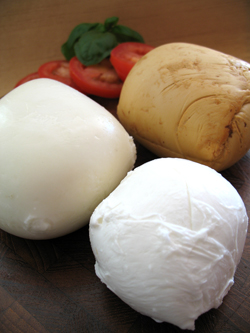 Clockwise from left: vacuum-packed fresh mozzarella, vacuum-packed smoked mozzarella and water-packed fresh mozzarella. Photo by Melody Lan.
Clockwise from left: vacuum-packed fresh mozzarella, vacuum-packed smoked mozzarella and water-packed fresh mozzarella. Photo by Melody Lan. |
The same goes for any lasagna, parmigiana or other dish made with fresh mozzarella. The difference is as significant as using a Bell & Evans chicken or Kurobuta pork: the dish becomes dazzling.
Mozzarella Fresca’s mozzarella is made with very little salt: if you want more, you can add it. There’s no titanium dioxide, which some producers use as a whitening agent: that snowy color is all-natural (as is the entire product line).
How To Enjoy The Fresh Mozzarella
- Hors d’Oeuvre. The smaller mozzarella balls make special and very popular hors d’oeuvre.
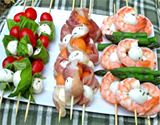 You can pair mozzarella with virtually anything in the cupboard: dates, olives, chunks of sopressata (a type of Italian salami) or your favorite meats. You can even pair them with chunks of contrasting cheeses, alternating with tomatoes, pickled onions, marinated mushrooms or other veggies. At the right, three different skewers: a “Caprese” with marinated mozzarella, grape tomatoes and fresh basil; melon balls and prosciutto with mozzarella; shrimp and poached asparagus tips with marinated mozzarella. It’s also easy to make crostini—check the Mozzarella Fresca website for recipes. You can pair mozzarella with virtually anything in the cupboard: dates, olives, chunks of sopressata (a type of Italian salami) or your favorite meats. You can even pair them with chunks of contrasting cheeses, alternating with tomatoes, pickled onions, marinated mushrooms or other veggies. At the right, three different skewers: a “Caprese” with marinated mozzarella, grape tomatoes and fresh basil; melon balls and prosciutto with mozzarella; shrimp and poached asparagus tips with marinated mozzarella. It’s also easy to make crostini—check the Mozzarella Fresca website for recipes.
- Appetizers. Our favorite easy-to-make, impressive crowd-pleaser is the “Mozzatini” in the martini glass, above.
- Salads. Water-packed fresh mozzarella (in an eight-ounce plastic tub) is very moist and ideal for salads and appetizers. You can have a Caprese salad, one of the most popular items at Italian restaurants, as often as you like at home: Just slice a ball of mozzarella and layer it with sliced tomato and basil leaves. Drizzle it with a little extra virgin olive oil and balsamic vinegar. Perfetto! For variety, it can be served stacked vertically in a column, as shown in the second photo.
Why don’t we enjoy this delicious salad more frequently at home? Often the answer is that the tomatoes aren’t good enough; but with mozzarella this good, you can marinate the tomatoes in the vinaigrette before assembling the salad, or substitute roasted red peppers. With the great flavor of the mozzarella, Caprese is a pleasure anytime, for a fraction what it costs at restaurants. If you love Caprese and like to make impressive dishes for dinner parties, check out the Ultimate Caprese salad in the recipe collection on the Mozzarella Fresca website.
Add the smaller perlini (“little pearls”) and bocconcini (boc-con-CHEE-nee, “delicacies”) to green salads, vegetable salads or pasta salads (or to hot pasta dishes). Some inspiration at the right, a capellini salad with perlini, arugula and grape tomatoes (recipe on the website).
|
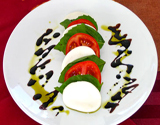
Caprese Salad.

Caprese “Napoleon.”
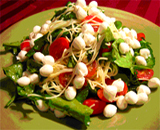
Perlini Salad. |
- Sandwiches and Omelets. We have rediscovered the joy of grilled cheese sandwiches using fresh mozzarella—regular or smoked—with tomatoes, sundried tomatoes or roasted red peppers. They’re our new favorite easy lunch. If you like pizza because of the crust, tomatoes and rich, melted mozzarella, try these. The cheeses also work beautifully in omelets, and the smaller sizes—perlini, bocconcini, ciliegine and ovoline—can easily be tossed into omelets or scrambled-egg mixtures or added to sandwiches, to be enjoyed as tasty cheese polka-dots.
- Entrées. Mozzarella Fresca’s vacuum-sealed fresh mozzarella is slightly less moist than the water-packed tub variety, and perfect for general cooking, pizza-making and sandwich prep. If you cook with mozzarella, your parmigianas and lasagnas will
 be instantly tastier. If you make pizza at home, you’ll discover what making it with a top-of-the-line cheese will do. If you don’t yet make pizza at home but order it in, we encourage you to buy a pre-made crust, fresh mozzarella and basil and some good sauce—Vino de Milo is exceptional but Emeril’s is fine. As a variation to slicing the large balls of mozzarella, you can sprinkle perlini (the little “pearls” of mozzarella in the salad photo above) or the larger bocconcini or ciliegine on pizza; they’ll melt into dots of mozzarella all over the pie. Cubes of the smoked mozzarella tossed into hot pasta are sublime. In the photo at the right, simple grilled swordfish becomes a party dish with an easy onion-mascarpone relish (recipe on the website). be instantly tastier. If you make pizza at home, you’ll discover what making it with a top-of-the-line cheese will do. If you don’t yet make pizza at home but order it in, we encourage you to buy a pre-made crust, fresh mozzarella and basil and some good sauce—Vino de Milo is exceptional but Emeril’s is fine. As a variation to slicing the large balls of mozzarella, you can sprinkle perlini (the little “pearls” of mozzarella in the salad photo above) or the larger bocconcini or ciliegine on pizza; they’ll melt into dots of mozzarella all over the pie. Cubes of the smoked mozzarella tossed into hot pasta are sublime. In the photo at the right, simple grilled swordfish becomes a party dish with an easy onion-mascarpone relish (recipe on the website).
- Inspired by the mozzarellas, we threw a “meatball sub” dinner party, the kind Mario Batali might cook if he were inviting friends over for meatball submarine sandwiches worthy of your good Barolos and Barberas.
| |
|
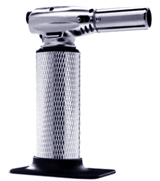 We made beef, pork and chicken meatballs, redolent of sage, thyme, oregano and other herbs; and three different sauces, one cooked with large pieces of delicious Italian pork sausage. We made beef, pork and chicken meatballs, redolent of sage, thyme, oregano and other herbs; and three different sauces, one cooked with large pieces of delicious Italian pork sausage. - We invited guests to prepare their ideal sub sandwiches by mixing and matching meatballs, mozzarellas (water-packed, vacuum-sealed and smoked vacuum-sealed) and hero rolls from some great Italian bakeries (dieters could opt for breadless meatballs in a ramekin). We melted everyone’s cheese with a chef’s torch (photo at right), the same kind used for caramelizing crème brulée, browning meringue, melting cheese on onion soup and blackening peppers and tomatoes for smoky salsas.
- We served a large salad; and for dessert, Dolce caramel mascarpone with berries (see below).
|
The result? Demands from friends (who heard it through the grapevine) that we have another party. (We convinced them that, having learned the drill, they should host the party so we could spend our time on more recipe development.)
Marinated Fresh Mozzarella
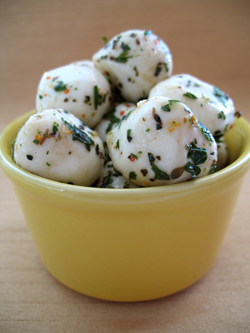 Some things are simply irresistible. Bite-size, marinated balls of mozzarella, made in the size called ciliegine (chee-lee-eh-GEE-nee), fall into that category (they’re the size of a twenty-five-cent piece). The marinade is excellent (we have not found this to be the case with some other brands). It’s made of extra virgin olive oil and herbs, with a bit of canola oil so the olive oil doesn’t harden in the refrigerator case; minced basil, garlic, parsley and red pepper plus a pinch of salt. If you want them spicy, you can add hot pepper flakes or a little chili oil (when we’re looking to heat things up, we add a tablespoon or two of Gil’s Habañero Tequila Oil to the mix). Some things are simply irresistible. Bite-size, marinated balls of mozzarella, made in the size called ciliegine (chee-lee-eh-GEE-nee), fall into that category (they’re the size of a twenty-five-cent piece). The marinade is excellent (we have not found this to be the case with some other brands). It’s made of extra virgin olive oil and herbs, with a bit of canola oil so the olive oil doesn’t harden in the refrigerator case; minced basil, garlic, parsley and red pepper plus a pinch of salt. If you want them spicy, you can add hot pepper flakes or a little chili oil (when we’re looking to heat things up, we add a tablespoon or two of Gil’s Habañero Tequila Oil to the mix).
If you can’t find the marinated balls, it’s easy to buy the plain variety and marinate them yourself. One friend prefers to do it that way; he adds a shot of aged balsamic vinegar for even more flavor.
How To Enjoy The Marinated Ciliegine
- With toothpicks. Pop them straight from the container into a serving dish and serve with toothpicks (you can fill a shot glass with toothpicks and provide a ramekin for discards). If you’re going to a dinner party and the host(s) mention that you can contribute something, offer to bring an hors d’oeuvre—marinated ciliegine. It couldn’t be easier, and the popularity quotient is high. Purchase a simple, attractive serving dish to serve the ciliegine and as a leave-behind hostess gift, and you’ll be the favorite guest!
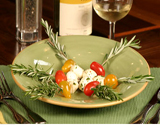 In an antipasto. At home, make an easy antipasto with ciliegine and slices of sopressata or other salami, pepperoncini, grilled vegetables and marinated artichoke hearts; or make skewers in any of the preparations from the Hors d’Oeuvre section above. For a special presentation, use rosemary sprigs instead of skewers, as in the photo at the right. In an antipasto. At home, make an easy antipasto with ciliegine and slices of sopressata or other salami, pepperoncini, grilled vegetables and marinated artichoke hearts; or make skewers in any of the preparations from the Hors d’Oeuvre section above. For a special presentation, use rosemary sprigs instead of skewers, as in the photo at the right.- In salads and with sandwiches. Marinated ciliegine add flavor to any salad, and garnish any sandwich platter.
Ricotta
Ricotta is a cooked-curd cheese, a group that includes cottage cheese, farmer’s cheese, 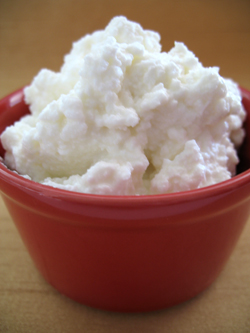 paneer (an Indian cheese), panela (a Mexican cheese), pot cheese (a drier form of cottage cheese) and queso fresco. Ricotta is snowy white, soft, mild but rich. Although its soft curds remind some of a sieved cottage cheese—and it is the closest thing to an Italian cottage cheese—its flavor is very different, with a slight natural sweetness. With added sugar, it makes delectable Italian pastries like cannoli and cassata. paneer (an Indian cheese), panela (a Mexican cheese), pot cheese (a drier form of cottage cheese) and queso fresco. Ricotta is snowy white, soft, mild but rich. Although its soft curds remind some of a sieved cottage cheese—and it is the closest thing to an Italian cottage cheese—its flavor is very different, with a slight natural sweetness. With added sugar, it makes delectable Italian pastries like cannoli and cassata.
Technically, ricotta is not a cheese at all, but a cheese by-product. The word ricotta comes from the Latin recoctus, which means “re-cooked.” The whey, which is drained away from the curd in the making of mozzarella and provolone, is re-boiled; lactic, citric or other acid (including vinegar) and a small amount of milk are added to make the whey curdle, and the tiny granular curds are collected and left to drain. The result is ricotta.
Depending on the milk that is used, ricotta can be very moist and spreadable or more dense and dry: the fat content will vary according to the milk that is used (Mozzarella Fresca’s cow’s milk ricotta is lighter than sheep or water buffalo ricotta). Mozzarella Fresca makes two ricottas: a traditional (made of 50% whey, 50% whole milk) and a lowfat (from 100% whey).
How To Enjoy The Ricotta
- In general cooking. If you cook Italian, you cook with ricotta. The most famous Italian dishes—lasagna, ravioli, stuffed shells and stuffed tube pasta like cannelloni—use ricotta, as do casseroles and innumerable savory and sweet dishes. “Pasta con la ricotta” is simple home cooking: toss spaghetti with butter, dot with ricotta, add fresh basil and grated pecorino or romano cheese. You also can add some ricotta to a tomato and basil sauce for creaminess. Mashed-potato lovers: mixed some ricotta into mashed potatoes along with butter and some grated cheddar. It’s a voluptuous fusion dish.
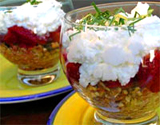 At breakfast or brunch. Dab ricotta on pancakes or French toast and drizzle with maple syrup. Spread it on toast or English muffins and dust with cinnamon sugar or add some preserves. Serve it plain or sweetened with fruit (sweeten with sugar, honey or artificial sweetener). Add it to granola, as in the photo at the right. At breakfast or brunch. Dab ricotta on pancakes or French toast and drizzle with maple syrup. Spread it on toast or English muffins and dust with cinnamon sugar or add some preserves. Serve it plain or sweetened with fruit (sweeten with sugar, honey or artificial sweetener). Add it to granola, as in the photo at the right. - As a dip and a spread. Ricotta adapts itself to many recipes. Instead of reaching for the sour cream, try blending your seasonings into ricotta, which is naturally low in fat.
- In diet plans. With a fat content of 4% to 10% (cottage cheese is 4%), ricotta works in diet plans. It is lower in salt than cottage cheese. (Mozzarella Fresca is at the lower end of the scale.)
- In desserts. Ricotta is a player in the dessert oeuvre: there are recipes galore for cheesecakes, puddings, crepes et al. There are also very attractive desserts that require no cooking, just some mixing and minor assembly. The simplest is to sweeten ricotta
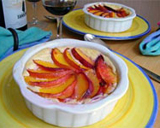 with a little honey (try lavender honey), spoon into dessert cups, goblets, chocolate cups or tart shells and top with berries. A more elegant variation is a Ricotta and Stone Fruit Timbale (photo at right). The recipe is on the Mozzarella Fresca website; but essentially, ricotta sweetened with honey and cinnamon forms the base of the dish, with a sliced nectarine or peach on top. You can broil the timbale (or use the chef’s torch featured above) to heat the fruit if you’d like to serve the dish warm. with a little honey (try lavender honey), spoon into dessert cups, goblets, chocolate cups or tart shells and top with berries. A more elegant variation is a Ricotta and Stone Fruit Timbale (photo at right). The recipe is on the Mozzarella Fresca website; but essentially, ricotta sweetened with honey and cinnamon forms the base of the dish, with a sliced nectarine or peach on top. You can broil the timbale (or use the chef’s torch featured above) to heat the fruit if you’d like to serve the dish warm.
Another no-bake dessert: blend ricotta, grated orange rind and sugar or honey; shave some chocolate if you like (or use mini chocolate morsels), and roll the mixture into store-bought crepes. Chill an hour or more until firm, plate, garnish with fresh raspberries and drizzle with raspberry purée or chocolate sauce (especially the white chocolate sauce from The King’s Cupboard). Those on sugar-restricted diets will enjoy ricotta mixed with Splenda or other artificial sweeteners (for a chocolate version, add cocoa). You can make sugar-free cannoli cream by adding some orange zest and shaved, sugar-free chocolate.
 Although it is made from whey, ricotta salata is not related to fresh ricotta. It is a hard sheep’s milk cheese, aged for a minimum of three months, that is used for grating or shaving. The cheese is lightly salted: salata means salted, and the term ricotta salada with a “d,” which is frequently found, is a misspelling. Milky-white in color, it is used in salads, pasta dishes or enjoyed drizzled with olive oil and crusty bread. Click here for more information. Although it is made from whey, ricotta salata is not related to fresh ricotta. It is a hard sheep’s milk cheese, aged for a minimum of three months, that is used for grating or shaving. The cheese is lightly salted: salata means salted, and the term ricotta salada with a “d,” which is frequently found, is a misspelling. Milky-white in color, it is used in salads, pasta dishes or enjoyed drizzled with olive oil and crusty bread. Click here for more information.
Mascarpone
Mascarpone is Italian cream cheese, originating in the Lombardy region of Northern Italy. Made from fresh heavy cream, it is rich, mild and buttery. It is used as a spread, as the main ingredient in popular Italian desserts such 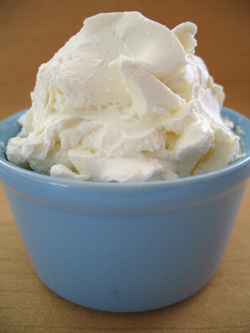 as tiramisu and to thicken sauces. While it has a slightly sweeter flavor profile than American cream cheese, it is wonderful on a bagel, English muffin or toast. as tiramisu and to thicken sauces. While it has a slightly sweeter flavor profile than American cream cheese, it is wonderful on a bagel, English muffin or toast.
Mascarpone is an uncooked-curd cheese; feta, fresh chèvre, fromage blanc and queso blanco also belong to this group. (While feta may seem aged, not a fresh cheese, it is neither. It is cured in a saltwater solution or whey for weeks or months. It is thus not like the other fresh cheeses, but an anomaly.)
Mozzarella Fresca’s mascarpone is made in the Italian style, smoother and creamier than most domestic products (it is also made with cream, not milk). It is head and shoulders above domestic mascarpones because of a slow heating process that makes it sweeter on the finish. Because of its smooth texture (it is not grainy like faster-produced, larger-batch products) it is so much better for cooking. And for mainlining: it is so dense and rich, that a spoonful or two with a tea biscuit (we like the Classici and the Zerole from Lazzaroni, which also are made in excellent sugar-free versions) and a few squares of great chocolate is the kind of simple but perfect dessert we make for ourselves when we’re not entertaining people who expect something more glamorous.
How To Enjoy The Mascarpone
- Make tiramisu. It’s everyone’s favorite Italian dessert these days.
- Poach pears in dessert wine. A Moscato d’Asti works for both poaching and drinking. You can top the pears with plain unsweetened mascarpone or add whipped mascarpone. To whip 1/2 cup of mascarpone, add 2 teaspoons of confectioners sugar and 1 teaspoon of milk; whip with a wire whisk or electric beaters. You can gild the lily (or the poached pear) with some shaved chocolate or chopped candied ginger.
- Serve with fresh fruit or fruit salad. Use the same two options as above, plain or sweetened.
- Make easy, no-bake dessert tarts. Spoon sweetened mascarpone into tart shells, add berries and drizzle with melted currant jelly (not jam) or a balsamic syrup. To sweeten 1 pound of mascarpone,
 add 1/3 cup of granulated sugar, 1/4 cup heavy cream (not ultra-pasteurized), 1 tablespoon real vanilla extract and 1/2 teaspoon grated orange rind. For the syrup, dissolve 3 tablespoons sugar in 1/2 cup of condimento-quality balsamic vinegar. Coat 3 pints of berries in the balsamic mixture (strawberries work best with balsamic) and chill for 2 or more hours, stirring occasionally to evenly coat the berries. Then drain the balsamic liquid into a saucepan, reserving the berries for the tart. Boil over medium-high heat for two minutes to reduce to syrup, stirring constantly; then remove from the heat and cool. You can pre-assemble the complete tarts if using the currant jelly, but wait until serving to spoon on the balsamic syrup. NOTE: You can buy excellent pre-made tart shells from Clearbook Farms in both regular and mini sizes. add 1/3 cup of granulated sugar, 1/4 cup heavy cream (not ultra-pasteurized), 1 tablespoon real vanilla extract and 1/2 teaspoon grated orange rind. For the syrup, dissolve 3 tablespoons sugar in 1/2 cup of condimento-quality balsamic vinegar. Coat 3 pints of berries in the balsamic mixture (strawberries work best with balsamic) and chill for 2 or more hours, stirring occasionally to evenly coat the berries. Then drain the balsamic liquid into a saucepan, reserving the berries for the tart. Boil over medium-high heat for two minutes to reduce to syrup, stirring constantly; then remove from the heat and cool. You can pre-assemble the complete tarts if using the currant jelly, but wait until serving to spoon on the balsamic syrup. NOTE: You can buy excellent pre-made tart shells from Clearbook Farms in both regular and mini sizes.
As with ricotta, you also can spoon sweetened mascarpone into chocolate cups and meringues. It can be further enhanced with citrus zest, cinnamon, chopped candied ginger, or any flavoring you like; but just plain is perfect.
- Make mascarpone cheesecake. If you make a great cheesecake with cream cheese, try it with Mozzarella Fresca mascarpone. It’s a bit more dense (there’s less water in the mascarpone) and it has a more elegant flavor. Use your own recipe, or try the recipe from Michael Chiarello’s Napa. It includes a biscotti crust that’s worth knowing about.
- Stuff dates. Mascarpone-stuffed dates are one of the easiest and most luxurious hors d’oeuvre or petit fours—and so few people think to serve them! There’s a recipe on Mozzarella Fresca’s website.
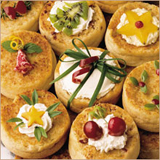 Spread on breads. If you’re a sybarite, mascarpone on toasted raisin bread, walnut bread, or currant walnut bread is a slice of paradise. On bagels too, of course. On cinnamon toast, substitute the mascarpone for butter. If you want to dazzle diners at your next brunch, try mascarpone instead of cream cheese—and definitely order the peerless English muffins from Wolferman’s (photo at right) to go with it. Spread on breads. If you’re a sybarite, mascarpone on toasted raisin bread, walnut bread, or currant walnut bread is a slice of paradise. On bagels too, of course. On cinnamon toast, substitute the mascarpone for butter. If you want to dazzle diners at your next brunch, try mascarpone instead of cream cheese—and definitely order the peerless English muffins from Wolferman’s (photo at right) to go with it. - Make frozen desserts. If you own an ice cream maker and you’ve never had mascarpone ice cream or sorbet, hunt down the nearest recipe and enjoy (there’s a recipe for Lemon Mascarpone Ice Cream on the website).
Dolce
At the end of dinner, when you want something sweet, reach for the Dolce, which means “sweet” in 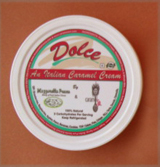 Italian. Mozzarella Fresca married its mascarpone to a previous NIBBLE selection, Caramel Sin, to create what appears to be a beige-colored mascarpone, but tastes like nothing you could have dreamed of. When you blend the best mascarpone with the best caramel, it is a match made in heaven. The only problem occurs at retail: since Dolce is Mozzarella Fresca’s proprietary name, most people don’t know what it is. If you pick up the package you can read that it is “Italian dessert creme,” but most of us need more explanation than that. Let us try to help further the understanding; because if you love rich desserts and you don’t try Dolce, you are missing out on a unique pleasure that transforms an ordinary cake, pie, panforte or plate of cookies into something quite unforgettable. Italian. Mozzarella Fresca married its mascarpone to a previous NIBBLE selection, Caramel Sin, to create what appears to be a beige-colored mascarpone, but tastes like nothing you could have dreamed of. When you blend the best mascarpone with the best caramel, it is a match made in heaven. The only problem occurs at retail: since Dolce is Mozzarella Fresca’s proprietary name, most people don’t know what it is. If you pick up the package you can read that it is “Italian dessert creme,” but most of us need more explanation than that. Let us try to help further the understanding; because if you love rich desserts and you don’t try Dolce, you are missing out on a unique pleasure that transforms an ordinary cake, pie, panforte or plate of cookies into something quite unforgettable.
Mix Caramel
Sin with
mascarpone
and you get
the celestial
Dolce. Such a simple
concept,
yet so
devastatingly
delicious.
Photos of Caramel Sin
and Dolce, at
right, and the
mascarpone in the section above, by
Melody Lan. |
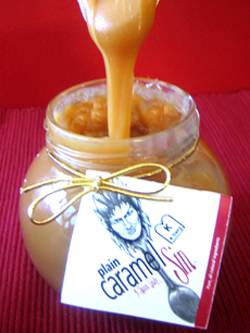 |
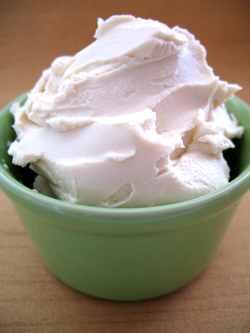 |
How To Enjoy Dolce
You can’t make Dolce at home—the caramel and mascarpone are blended at the plant at high temperatures. But after you taste it, you won’t mind going out of your way to buy it! Dolce is one of those simple but magical products—we call them transformational foods because they turn other good foods into something amazing. Take a plain piece of cake, an empty tart shell, berries...a sliced banana from the kitchen counter in a goblet with a tablespoon of Dolce becomes an event.
- Replace the mascarpone. Everything that works for plain mascarpone works for Dolce, too.
- Make parfaits. Layer Dolce in parfait dishes or goblets with fruit salad, berries or ice cream.
- Serve with biscotti or plain cookies. Put Dolce in a ramekin (as we’ve done in the photo above) or sake cup or directly on the plate. Provide butter knives or cheese spreaders.
- Garnish ice cream, cakes, brownies and cookies. Make cookie sandwiches, or serve Dolce as a garnish on the side. It is perfection with chocolate cake, pecan pie, apple pie, carrot cake and pumpkin pie.
- Fill tart shells, chocolate cups or meringues with Dolce. Garnish with berries, chocolate chips or chocolate shavings or candied grapefruit peel. If you’re ready to go over the edge, fill miniature cannoli shells with Dolce.
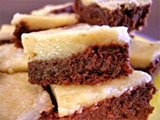 Bake with it. Use as you would mascarpone, but enjoy more nuance of flavor from the caramel. (The recipe for the brownies at the right adds a layer of Dolce on top for something very special indeed—recipe on the website.) Bake with it. Use as you would mascarpone, but enjoy more nuance of flavor from the caramel. (The recipe for the brownies at the right adds a layer of Dolce on top for something very special indeed—recipe on the website.) - Eat it right out of the container. It’s like eating ice cream from the carton, but it doesn’t melt.
The review continues below.
Cook Italian With Giada!
Here are two wonderful books from one of our favorite Italian chefs, Giada de Laurentiis. We love her show, Cooking Italian, on the Food Network.
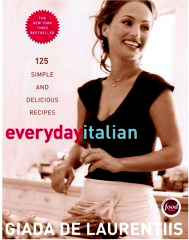 |
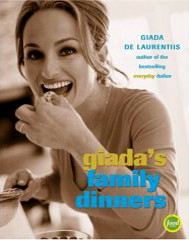 |
Everyday Italian: 125 Simple and
Delicious Recipes, by Giada de
Laurentiis. Learn how to cook with
minimum fuss for maximum flavor. For those who don’t have all day to cook, there are easy recipes for popular dishes like Clams Oreganata, Caprese Salad, Salsa all’Amatriciana, Fettuccine Alfredo, Veal Marsala, Caponata and Chocolate Tiramisu. THIS BOOK IS A BESTSELLER. $20.48. Click here for more information. |
Giada's Family Dinners, by Giada de Laurentiis. Do-able dishes with an emphasis on feeding a crowd. There are traditional Italian holiday foods like Easter Pie, Pizza Rustica, and Panettone Bread Pudding with Amaretto Sauce; plus twists on Thanksgiving classics like Turkey with Herbes de Provence and Citrus, Ciabatta Stuffing with Chestnuts and Pancetta, and Butternut Squash Lasagna. $19.50. Click here for more information. |
|
Father’s Day Gifts
Ten of our favorite gifts are included in our 2006 list of recommendations for Dad in the May issue of THE NIBBLE™ online magazine. You can check our 2005 list, too.
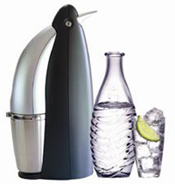
The Penguin Soda and Seltzer maker is one of our favorite items for the dinner table, bar or patio (no electricity needed). If Dad is watching his calories, the all-natural soda mixes have diet varieties, plus Dad can custom-make seltzer as carbonated as he likes. Click here to read our review. |
Cheese, Please: Our Most Popular Cheese Articles
To learn more about cheese, read these articles in THE NIBBLE:
|
Where To Begin: Serving Suggestions
We’ve provided numerous serving suggestions for each of the five Mozzarella Fresca products, which have resulted in many options. But it’s really quite simple. Just get one of everything and serve them at one nice brunch or lunch with:
- Good Italian breads
- Sliced tomatoes, basil, arugula
- Grilled vegetables
- Italian cold cuts for sandwiches
- Salad greens
- Olive oil and balsamic vinegar
- Sea salt and a pepper grinder
- Berries
- Biscotti, shortbread or tea biscuits, so you can try the ricotta and mascarpone—and of course, the Dolce—in a sweet course as well as a savory one
Let people make their own Caprese salad or sandwiches and dish up the cheeses as they wish; conclude with berries, mascarpone and Dolce. There won’t be “too much cheese”: Unlike aged cheeses, fresh cheeses are very light, like cottage cheese and yogurt. You can have some of everything, and not feel like you’ve over-indulged. Mangia!
—Karen Hochman
FORWARD THIS NIBBLE to cheese-lovers, cooks and those who think there can’t be brilliance in mascarpone and ricotta.
MOZZARELLA FRESCA
Fresh Italian Cheeses Including Mascarpone, Mozzarella, Ricotta and Dolce (Caramel Mascarpone)
Certified Kosher (Dairy) by Tablet-K
- Products are sold at specialty food stores
and chains including Albertson’s, Costco
(Northeast), Kroger, Whole Foods Markets
(Midwest and West), Safeway.
- For a store locator, visit
MozzarellaFresca.com
Prices are verified at publication but are subject to change.
|
 |
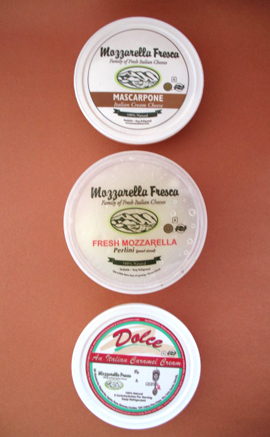
From top: Mascarpone, Fresh Mozzarella (Perlini), Dolce.
|
Read about some of our other
favorites cheeses & dairy products
in THE NIBBLE online magazine:
|
|
More Favorite Cheese Books
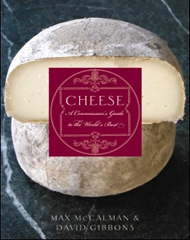 |
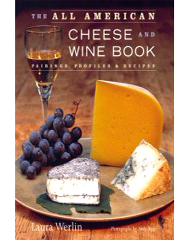 |
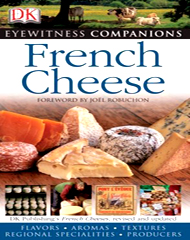 |
| Cheese: A Connoisseur’s Guide to The World’s Best, by Max McCalman. Maître Fromager McCalman profiles 200 of the world’s very best cheeses from A (Aarauer Bierdeckel) to Z (Zamorano). A wonderful book, complete with all the practical information and fascinating details a connoisseur could want. Click here for more information. |
The All American Cheese and Wine Book, by Laura Werlin. Excellent suggestions on pairing wines with cheese, with an education on why certain matches work and why others don’t. Easy recipes for entertaining with cheese, and a nice introduction to artisan cheesemakers and winemakers. Click here for more information. |
French Cheese, by DK Publishing. French cheeses are considered the crème de la crème. This highly informative reference provides the history and essential information on each type of cheese, as well as advice as what wine to drink with it. Click here for more information. |
Cook With The Two Grand Dames of Italian Cuisine
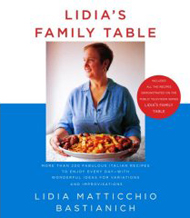 |
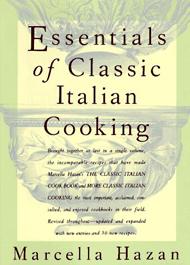 |
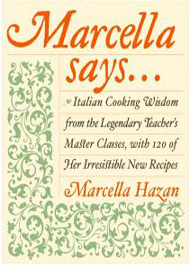 |
| Lidia’s Family Table, by Lidia Bastianich. These are the dishes Lidia cooks for her family. Most are hearty dishes that can be served family-style, with both easy and challenging projects and ideas for variations and improvisations. There are some elegant choices for dinner parties as well. Click here for more information. |
Essentials of Classic Italian Cooking, by Marcella Hazan. The original reference for American cooks, a must for any library. A delicious collection of recipes for cooks of every skill level. Recipes have been revised to reduce fat content, and more important reference material has been added. Click here for more information. |
Marcella Says...: Italian Cooking Wisdom from the Legendary Teacher’s Master Classes, with 120 of Her Irresistible New Recipes, by Marcella Hazan. The title says it all: If you couldn’t be at the master class, you can glean all the wisdom—and the recipes—from the book. Click here for more information. |
FOR ADDITIONAL INFORMATION, special offers,
contests, opinion surveys, THE NIBBLE prior issues archive, product gift-finder and more,
visit the home page of TheNibble.com.
Do you have friends who would enjoy THE NIBBLE?
Click here to send them an invitation to sign up for their own copy.
|
ABOUT THE NIBBLE™. THE NIBBLE™, Great Food Finds™, is an online magazine plus newsletters about specialty foods and the gourmet life. It is the only consumer publication and website that focuses on reviewing the best specialty foods and beverages, in every category. The magazine also covers tabletop items, gourmet housewares, and other areas of interest to people who love fine food.
© Copyright 2004-2025 Lifestyle Direct, Inc. All rights
reserved. All information contained herein is subject to change at any time
without notice. All details must be directly confirmed with manufacturers, service
establishments and other third parties. The material in this newsletter may not
be reproduced, distributed, transmitted, cached, or otherwise used, except with
the prior written permission of Lifestyle Direct, Inc.
|
 |
|
 |